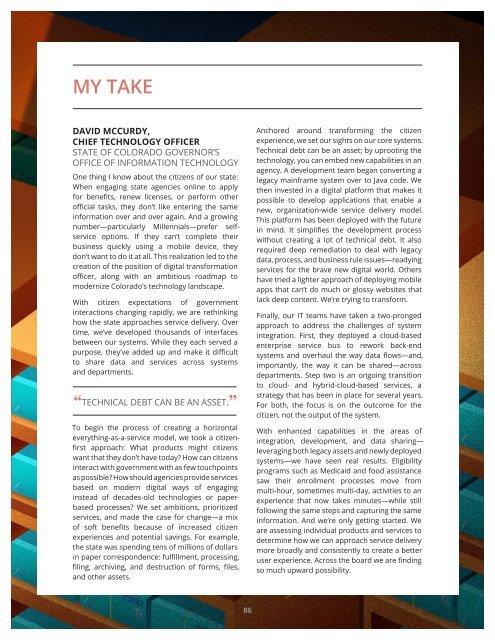Trending the trends Eight years of research
2kcf8xh
2kcf8xh
You also want an ePaper? Increase the reach of your titles
YUMPU automatically turns print PDFs into web optimized ePapers that Google loves.
Tech Trends 2017 The kinetic enterprise<br />
MY TAKE<br />
DAVID MCCURDY,<br />
CHIEF TECHNOLOGY OFFICER<br />
STATE OF COLORADO GOVERNOR’S<br />
OFFICE OF INFORMATION TECHNOLOGY<br />
One thing I know about <strong>the</strong> citizens <strong>of</strong> our state:<br />
When engaging state agencies online to apply<br />
for benefits, renew licenses, or perform o<strong>the</strong>r<br />
<strong>of</strong>ficial tasks, <strong>the</strong>y don’t like entering <strong>the</strong> same<br />
information over and over again. And a growing<br />
number—particularly Millennials—prefer selfservice<br />
options. If <strong>the</strong>y can’t complete <strong>the</strong>ir<br />
business quickly using a mobile device, <strong>the</strong>y<br />
don’t want to do it at all. This realization led to <strong>the</strong><br />
creation <strong>of</strong> <strong>the</strong> position <strong>of</strong> digital transformation<br />
<strong>of</strong>ficer, along with an ambitious roadmap to<br />
modernize Colorado’s technology landscape.<br />
With citizen expectations <strong>of</strong> government<br />
interactions changing rapidly, we are rethinking<br />
how <strong>the</strong> state approaches service delivery. Over<br />
time, we’ve developed thousands <strong>of</strong> interfaces<br />
between our systems. While <strong>the</strong>y each served a<br />
purpose, <strong>the</strong>y’ve added up and make it difficult<br />
to share data and services across systems<br />
and departments.<br />
“TECHNICAL DEBT CAN BE AN ASSET.”<br />
To begin <strong>the</strong> process <strong>of</strong> creating a horizontal<br />
everything-as-a-service model, we took a citizenfirst<br />
approach: What products might citizens<br />
want that <strong>the</strong>y don’t have today? How can citizens<br />
interact with government with as few touchpoints<br />
as possible? How should agencies provide services<br />
based on modern digital ways <strong>of</strong> engaging<br />
instead <strong>of</strong> decades-old technologies or paperbased<br />
processes? We set ambitions, prioritized<br />
services, and made <strong>the</strong> case for change—a mix<br />
<strong>of</strong> s<strong>of</strong>t benefits because <strong>of</strong> increased citizen<br />
experiences and potential savings. For example,<br />
<strong>the</strong> state was spending tens <strong>of</strong> millions <strong>of</strong> dollars<br />
in paper correspondence: fulfillment, processing,<br />
filing, archiving, and destruction <strong>of</strong> forms, files,<br />
and o<strong>the</strong>r assets.<br />
Anchored around transforming <strong>the</strong> citizen<br />
experience, we set our sights on our core systems.<br />
Technical debt can be an asset; by uprooting <strong>the</strong><br />
technology, you can embed new capabilities in an<br />
agency. A development team began converting a<br />
legacy mainframe system over to Java code. We<br />
<strong>the</strong>n invested in a digital platform that makes it<br />
possible to develop applications that enable a<br />
new, organization-wide service delivery model.<br />
This platform has been deployed with <strong>the</strong> future<br />
in mind. It simplifies <strong>the</strong> development process<br />
without creating a lot <strong>of</strong> technical debt. It also<br />
required deep remediation to deal with legacy<br />
data, process, and business rule issues—readying<br />
services for <strong>the</strong> brave new digital world. O<strong>the</strong>rs<br />
have tried a lighter approach <strong>of</strong> deploying mobile<br />
apps that can’t do much or glossy websites that<br />
lack deep content. We’re trying to transform.<br />
Finally, our IT teams have taken a two-pronged<br />
approach to address <strong>the</strong> challenges <strong>of</strong> system<br />
integration. First, <strong>the</strong>y deployed a cloud-based<br />
enterprise service bus to rework back-end<br />
systems and overhaul <strong>the</strong> way data flows—and,<br />
importantly, <strong>the</strong> way it can be shared—across<br />
departments. Step two is an ongoing transition<br />
to cloud- and hybrid-cloud-based services, a<br />
strategy that has been in place for several <strong>years</strong>.<br />
For both, <strong>the</strong> focus is on <strong>the</strong> outcome for <strong>the</strong><br />
citizen, not <strong>the</strong> output <strong>of</strong> <strong>the</strong> system.<br />
With enhanced capabilities in <strong>the</strong> areas <strong>of</strong><br />
integration, development, and data sharing—<br />
leveraging both legacy assets and newly deployed<br />
systems—we have seen real results. Eligibility<br />
programs such as Medicaid and food assistance<br />
saw <strong>the</strong>ir enrollment processes move from<br />
multi-hour, sometimes multi-day, activities to an<br />
experience that now takes minutes—while still<br />
following <strong>the</strong> same steps and capturing <strong>the</strong> same<br />
information. And we’re only getting started. We<br />
are assessing individual products and services to<br />
determine how we can approach service delivery<br />
more broadly and consistently to create a better<br />
user experience. Across <strong>the</strong> board we are finding<br />
so much upward possibility.<br />
86


